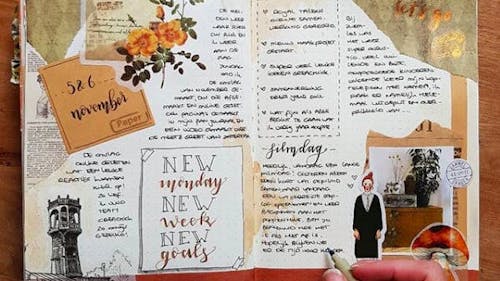For digital generation, how art of journaling has evolved

Gone are the days of sporadic and scribbled daily journals that start with an intimate “Dear Diary …” on the yellowed pages of leather notebooks. In 2018, the written tradition of journaling has not necessarily become obsolete. Rather, it has adapted to digital culture and taken more concise, permanent, portable and visual forms through social media.
Whether you prefer to use 280 characters on Twitter or create lengthy text and pictorial narratives on Tumblr, there’s no denying that the internet provides us with a multitude of modes to express ourselves. Still, it often feels as though any personal expression of our thoughts and emotions are lost in the endless sea of information on social media, which takes away the beauty and intimacy that physical diaries exude.
The digital record that our social media profiles collectively create portrays our public image, but this record gives no insight of the most private aspects of our character. Diaries of famous figures in history, literature and science, such as those of Charles Darwin, Anne Frank, Franz Kafka and Sylvia Plath, contextualize and better articulate much of their legacy today. The simple but poignant act of putting a pen to paper and allowing one’s stream of consciousness to take over creates a greater sense of self-awareness upon later reflection. Our written thoughts allow us to observe our personal growth over time.
Nowadays, apart from traditional diaries, journals are variant and can flexibly document any topic that we perceive as important to our lives like travel, food or fashion. Arts and craft journals can be likened to a combination of sketchbooks and scrapbooks. These can act as a hobbyists’ means of collating visuals in the form of mood boards representative of their different creative interests accessorized with text, pictures, sketches, stickers, washi tape and other materials.
Health journals help fitness experts and amateurs alike track their habits, metrics and work toward achieving their goals.
The most popular type of modern-day journal is without a doubt the Bullet Journal. Essentially a system of productivity created by New York-based product designer and writer Ryder Carroll, the Bullet Journal markets itself as an “analog method for the digital age” and is adaptable to anyone’s planning needs. It is an increasingly trendy form of journaling on academic savvy Tumblr, or "Studyblr."
Despite the general perception today that the art of journaling is a dying one, the aesthetically pleasing images of millennials’ journals that circulate online are motivating more people to grab a notebook and begin writing. Christina Flynn, a School of Arts and Sciences first-year who enjoys calligraphy, loves using her Bullet Journal as a brain-dump of sorts to jot down her thoughts in a beautiful way and structure her week.
“I feel more organized having a physical rather than digital space to plan my daily activities. My Bullet Journal gives me a sense of purpose and makes me feel like I know what I’m doing,” she said.
In contrast to the systematic nature of the Bullet Journal, ready-made DIY journals that allow you to explore and embrace your creativity have also sparked interest among young people. Books like conceptual artist and illustrator Keri Smith’s innovative "Wreck This Journal" and "The Imaginary World Of … " prompt journal enthusiasts of all expertise levels to write, draw and in general, create something of personal significance. The unique prompts of such ready-made journals allow people to let their imaginations run wild without the looming fear of writer’s or artist’s blocks.
The practice of journaling is introspective and therefore preached as a method of self-care. To dismiss journals as archaic in today’s day and age would be to undermine our generation’s unique ability to constantly communicate and contemplate.



